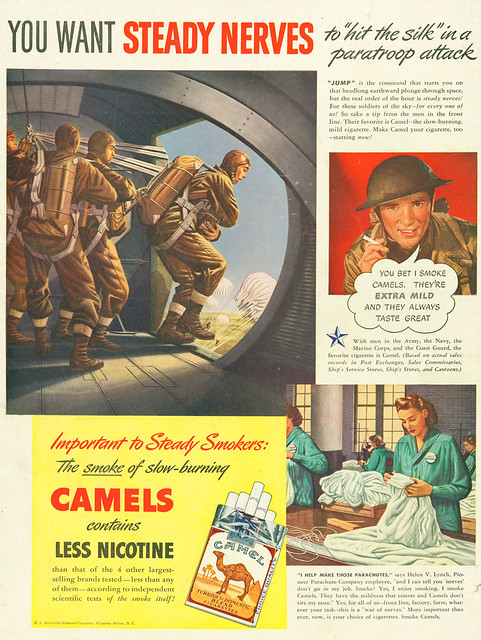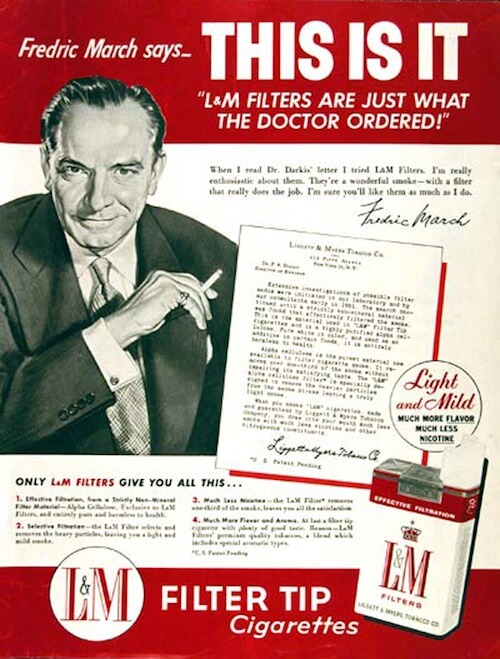Why I Smoked “L&M’s”.
Posted on | August 13, 2014 | 2 Comments

Mike Magee
An editorial in this week’s New England Journal of Medicine asks, “Is it time for a tobacco-free military?”(1) The article nicely summarizes the arguments for (few) and against (many) the promotion of cigarette tobacco on bases, in the commissaries, and on the battle field. It also lays out accurately that previous attempts to create a cigarette free military have been blocked by Congress, whose members were responding to Tobacco company lobbyists. What the article does not do is lay out the historical use of the military by tobacco interests to seed and addict new users (and subsequently their families) and to wrap their product in the American flag while claiming health benefits for their deadly product.
I smoked my first cigarette in the Spring of 1957 at the age of 9. My brand of choice was “L&M”, not based on the quality of the tobacco or any emotionally based brand loyalty, but because they were accessible. My parents kept a carton of them in a corner cabinet in the kitchen. They were light smokers, primarily lighting up with a cup of coffee after dinner. So a carton could last a long time. And believe it or not, you could sneak out one of the ten packs and they wouldn’t even notice it.
By then, there were 10 of us with my brother Steven, number 11, due that September. Having snatched the pack and stuffed it in my pocket, I cajoled my older sister, Pat, and my younger brother, Dan, into joining me and we headed out the back door into the protective woods and weeds that formed the center island of Abbott Boulevard. Here we were well hidden and secure, able to figure out together for the first time how to light up, breathe in the burning smokey air, and expel it in paroxysms of coughing. It wasn’t pleasant, but it was a necessary ritual if we expected to grow up.
It’s unlikely that my father smoked L&M’s during the war. Instead he probably relied on Camel’s or Lucky Strikes, depending on what was available.(2) The war years were tense, a fact of life that didn’t escape tobacco marketers. They sold the message hard and wrapped it in the American flag.

For example, one wartime print ad included a collage of paratroopers in a plane, an individual soldier, and a woman sewing a silk parachute in a wartime factory. The header read “YOU WANT STEADY NERVES to ‘hit the silk’ in a paratroop attack.” The text begins, “ ‘JUMP’ is the command that starts you on that headlong earthward plunge through space, but the real order of the hour is ‘steady nerves’. For these soldiers of the sky – for every one of us! So take a tip from the men on the front line.Their favorite is Camel – the slow-burning, mild cigarette. Make Camel your cigarette, too – starting now!”
The soldier is eye to eye with the reader and couldn’t agree more. His text bubble, “YOU BET I SMOKE CAMELS. THEY’RE EXTRA MILD AND THEY ALWAYS TASTE GREAT.” Below him, in small print, next to a military 3-D star, the reader finds evidence: “With men in the Army, the Navy, the Marine Corps and the Coast Guard, the favorite cigarette is Camel. (Based on actual sales records in Post Exchanges, Sales Commissaries, Ship’s Stores, and Canteens.)”
Not to be forgotten, the woman factory worker – eyes on the job as she diligently labors alongside her sister workers, sewing those parachutes by hand with tight, even stitches – comments, “ ‘I HELP MAKE THOSE PARACHUTES’, says Helen V. Lynch, Pioneer Parachute Company employee, ‘And I can tell you nerves don’t go in my job. Smoke? Yes, I enjoy smoking. I smoke Camels. They have the mildness that counts and Camels don’t tire my taste.’ Yes, for all of us – front line, factory, farm, whatever your task – this is a ‘war of nerves.’ More important than ever, now, is your choice of cigarettes. Smoke Camel.”

Another Camel ad from the same vintage prefers shorthand and heavy branding. The ad is bright yellow. The box of Camels is set diagonal and drawn in 3-D on the upper two-thirds with the famous camel and the notation, “TURKISH & DOMESTIC BLEND CIGARETTES”. The message, short, sweet and bold on the lower third, “CAMELS – SMOKE AS MANY AS YOU WANT…THEY NEVER GET ON YOUR NERVES!”
In the post-war period, infusing values, limiting anxiety, and relieving depression, were continually referenced in code. “Camel gives you honest enjoyment, clean-cut taste, easygoing mildness. Moments seem to brighten up every time you light one up”, reads one ad. Along the same line, a post-war Lucky Strike ad features a smiling, cheerful woman handing a cigarette to her grimacing, angry-looking husband whose back is turned to her, with the out-of-sync and somewhat unnerving message, “To anxiety…I bring relief. I’m your best friend. I am your Lucky Strike.”

By 1957, my father had plenty to be anxious about. As we recently learned, the tobacco industry worked hand in hand with the “Father of Stress”, endocrinologist Hans Selye, to “medicalize” the jitters, and offer a remedy – tobacco. (3) At the same time, cardiologists Meyer Friedman and Ray Roseman, came up with the “Type A” personality.(3) They were tobacco consultants as well, and tobacco was relaxant of choice.
But why “L&M’s”? The answer likely can be found in one of their ads at the time which featured the actor Frederic March. (In another version, the actress Rosalind Russell is featured). The header says, “L&M FILTERS ARE JUST WHAT THE DOCTOR ORDERED!” In the body of the ad is a picture of the actor saying, “When I read Dr. Darkis’ letter I tried L&M filters. I’m really enthusiastic about them. They’re a wonderful smoke – with a filter that really does the job.”

For validation, the ad includes a copy of Dr. F.R. Darkis’s letter. Turns out, Darkis was actually a chemist not a medical doctor.(2) He is listed as “Director of Research” for Liggett and Myers Tobacco located at 450 Fifth Avenue, New York, NY. The letter reads,
“Extensive investigations of possible filter media were initiated in our laboratory and by our consultants early in 1951. The search continued until a strictly non-mineral material was found that effectively filtered the smoke. This is the material used in “L&M” filter tip cigarettes and is a highly purified health cellulose. Pure white in color and used as an additive in certain foods, it is entirely harmless to health.
Alpha cellulose is the purest material now available to filter cigarette smoke. It removes over one third of the smoke without impairing it’s satisfying taste. The ‘L&M’ alpha cellulose filter is specifically designed to remove the heavier particles from the smoke stream leaving a truly light smoke.
When you smoke ‘L&M’ cigarettes made and guaranteed by Liggett and Myers Tobacco Company, you draw into your mouth much less smoke with much less nicotine and other nitrogenous constituents.”
For my father, the “EFFECTIVE FILTRATION” bannered on the top of each pack must have been reassuring, as well as the non-harmful nature of “alpha cellulose”, and the claims that it weeded out nicotine and harmful nitrogenous particles. Both my mother and father seemed to enjoy a good smoke, and did it it with a certain amount of flair and sophistication, especially at the dinner table on Sunday afternoons, with all of us sitting around focused on dessert while they sipped their coffee.
As for me, I was OK with stealing from the family stash, and I liked sharing the illicit catch with my siblings. But honestly, that first experience was not a pleasant one, and so I didn’t immediately get hooked. But eventually I did, and from my late teens through surgical residency, I did smoke when I had the money to buy cigarettes. I only stopped when my wife threatened to divorce me (I think she was kidding but was never certain), in my fourth year of surgical training.
What I did like, even as a child, was the aesthetics – the red and white, clean and clear design of the package, the compact container with 20 identical cigarettes standing tightly, side to side, the appearance of smoke sifting off the tip of this small fire stick, and the idea of “coming of age” smoking. In this regard, I tended to align with William L. Dunn, a PhD in Psychology from Duke and “Principal Scientist” in 1972 at Phillip Morris. Another one of those doctor look-alike’s, he waxed poetic with these observations: “The cigarette is among the most awe inspiring examples of the ingenuity of man. This cigarette should be conceived not as a product but as a package. The product is nicotine. The cigarette is but one of many package layers. There is the carton which contains the pack which contains the cigarette which contains the smoke. The smoke is the final package. The smoker must rip off all these package layers to get to that with chiefly which he seeks. Smoke is beyond question the most optimized vehicle of nicotine and the cigarette the most optimized dispenser of smoke.”(4)
Erotic pulmonary pleasures aside, as the tobacco industry lines up behind “smokeless tobacco” and “electronic cigarettes”, we should bear in mind that there is a history of “failed promises” and partial complicity between Medicine and the tobacco industry. And we need to make sure, it doesn’t happen again.
For Health Commentary, I’m Mike Magee
References:
3. Spiegel A et al. The Secret History Behind the Science of Stress. July 7, 2014. NPR. http://www.npr.org/blogs/health/2014/07/07/325946892/the-secret-history-behind-the-science-of-stress
5. Cummings KM, Morley CP, Hyland A. Failed promises of the cigarette industry and its effect on consumer misperceptions about health risks of smoking.Tob Control 2002;11:i110-i117. http://tobaccocontrol.bmj.com/content/11/suppl_1/i110.full
Tags: Camels > cigarette advertisements > cigarette industry > cigarette use by the military > doctors and cigarettes > E-cigarettes > electronic cigarettes. > L & M > Lucky Strike > public health > world war II cigarette ads
Comments
2 Responses to “Why I Smoked “L&M’s”.”



August 13th, 2014 @ 7:20 pm
(corrected)
“More Doctors Smoke CAMELS Than Any Other Cigarette.”
“20,679 Doctors Say LUCKIES Are Less Irritating.”
“38,381 Dentists Say: Smoke VICEROYS”
“Doctors (an Medical Authorities) Report PHILLIP MORRIS Far Less Irritating To The Nose And Throat”
“Just What The Doctor Ordered.. L&M”
Even Santa Claus (who spends much of his time inside chimneys) says “LUCKIES Are Easy On My Throat”
These and other examples can be seen by doing a quick image search for “cigarette advertising doctors.” For decades the tobacco industry actively co-opted the medical and science communities in order profit by misleading the public. Deceptive claims they made back then still have dire consequences today. Generations of children born long after the crackdown on tobacco advertising continue to be exposed to the harmful, addictive effects of second hand smoke which predisposes them to follow their elders.
Tobacco companies should not expect to bank huge profits while pawing off the proven costs of healthcare to the rest of society. They should be held financially liable for as long as they are in business.
August 14th, 2014 @ 8:09 am
Thanks for these Randy!